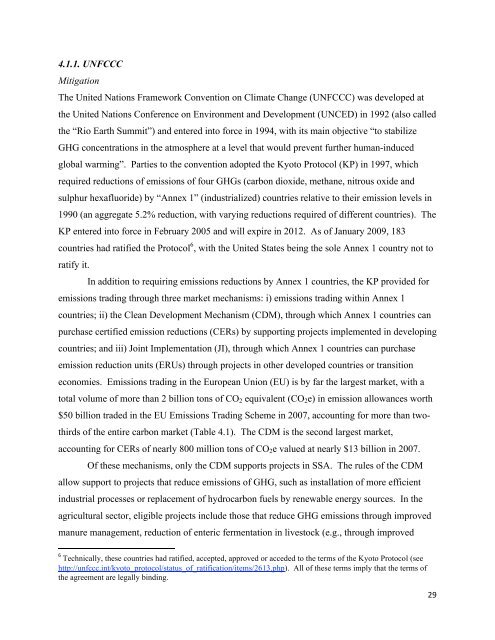The Role of Sustainable Land Management for Climate ... - CAADP
The Role of Sustainable Land Management for Climate ... - CAADP
The Role of Sustainable Land Management for Climate ... - CAADP
Create successful ePaper yourself
Turn your PDF publications into a flip-book with our unique Google optimized e-Paper software.
!<br />
4.1.1. UNFCCC<br />
Mitigation<br />
<strong>The</strong> United Nations Framework Convention on <strong>Climate</strong> Change (UNFCCC) was developed at<br />
the United Nations Conference on Environment and Development (UNCED) in 1992 (also called<br />
the “Rio Earth Summit”) and entered into <strong>for</strong>ce in 1994, with its main objective “to stabilize<br />
GHG concentrations in the atmosphere at a level that would prevent further human-induced<br />
global warming”. Parties to the convention adopted the Kyoto Protocol (KP) in 1997, which<br />
required reductions <strong>of</strong> emissions <strong>of</strong> four GHGs (carbon dioxide, methane, nitrous oxide and<br />
sulphur hexafluoride) by “Annex 1” (industrialized) countries relative to their emission levels in<br />
1990 (an aggregate 5.2% reduction, with varying reductions required <strong>of</strong> different countries). <strong>The</strong><br />
KP entered into <strong>for</strong>ce in February 2005 and will expire in 2012. As <strong>of</strong> January 2009, 183<br />
countries had ratified the Protocol 6 , with the United States being the sole Annex 1 country not to<br />
ratify it.<br />
In addition to requiring emissions reductions by Annex 1 countries, the KP provided <strong>for</strong><br />
emissions trading through three market mechanisms: i) emissions trading within Annex 1<br />
countries; ii) the Clean Development Mechanism (CDM), through which Annex 1 countries can<br />
purchase certified emission reductions (CERs) by supporting projects implemented in developing<br />
countries; and iii) Joint Implementation (JI), through which Annex 1 countries can purchase<br />
emission reduction units (ERUs) through projects in other developed countries or transition<br />
economies. Emissions trading in the European Union (EU) is by far the largest market, with a<br />
total volume <strong>of</strong> more than 2 billion tons <strong>of</strong> CO 2 equivalent (CO 2 e) in emission allowances worth<br />
$50 billion traded in the EU Emissions Trading Scheme in 2007, accounting <strong>for</strong> more than twothirds<br />
<strong>of</strong> the entire carbon market (Table 4.1). <strong>The</strong> CDM is the second largest market,<br />
accounting <strong>for</strong> CERs <strong>of</strong> nearly 800 million tons <strong>of</strong> CO 2 e valued at nearly $13 billion in 2007.<br />
Of these mechanisms, only the CDM supports projects in SSA. <strong>The</strong> rules <strong>of</strong> the CDM<br />
allow support to projects that reduce emissions <strong>of</strong> GHG, such as installation <strong>of</strong> more efficient<br />
industrial processes or replacement <strong>of</strong> hydrocarbon fuels by renewable energy sources. In the<br />
agricultural sector, eligible projects include those that reduce GHG emissions through improved<br />
manure management, reduction <strong>of</strong> enteric fermentation in livestock (e.g., through improved<br />
!!!!!!!!!!!!!!!!!!!!!!!!!!!!!!!!!!!!!!!!!!!!!!!!!!!!!!!!!!!!!<br />
) !Technically, these countries had ratified, accepted, approved or acceded to the terms <strong>of</strong> the Kyoto Protocol (see<br />
http://unfccc.int/kyoto_protocol/status_<strong>of</strong>_ratification/items/2613.php). All <strong>of</strong> these terms imply that the terms <strong>of</strong><br />
the agreement are legally binding.!<br />
!<br />
%,!

















